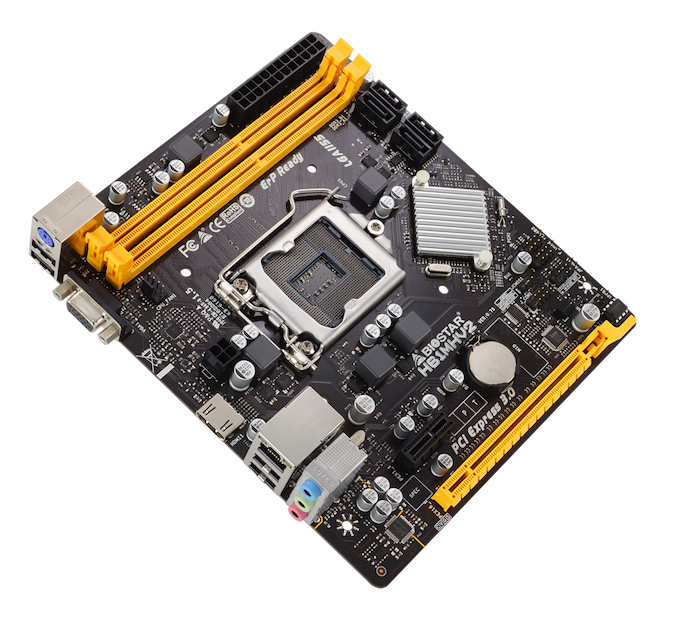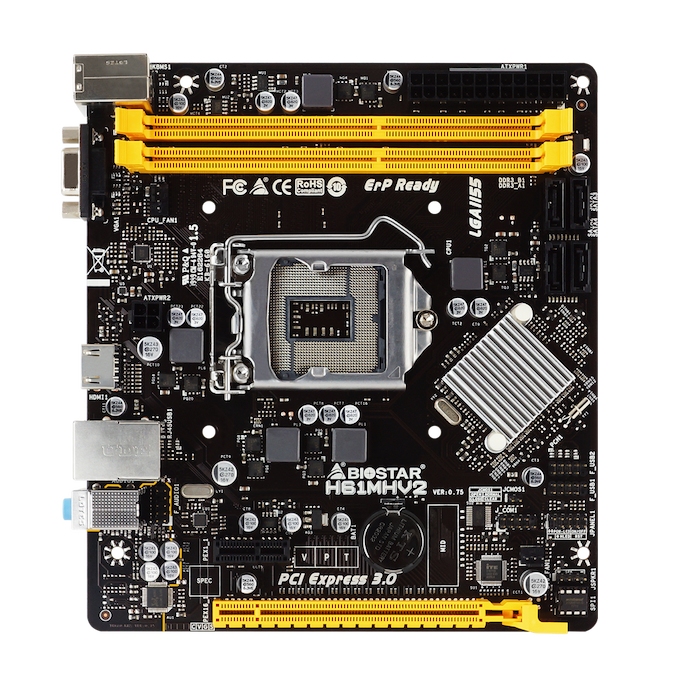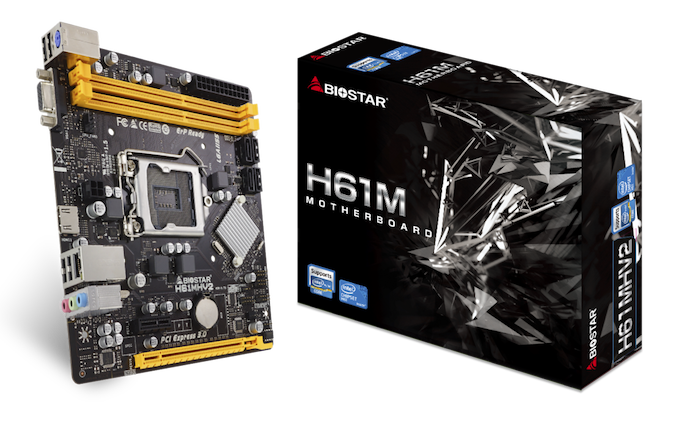2011 is Calling: Biostar Relaunches H61 Chipset in 2020
by Dr. Ian Cutress on February 27, 2020 4:45 AM EST- Posted in
- Motherboards
- Intel
- Biostar
- Sandy Bridge
- Ivy Bridge
- H61

Almost a decade ago, with the launch of Intel’s Sandy Bridge processors, came the H61 chipset. Compared to the high-end P67 and Z68 models, the idea behind H61 is that it was cheap, and it was long-life. At a time when low power embedded Atom CPUs still didn’t have enough power, H61 was there to be equipped with one of Intel’s new-fangled Core processors, with the systems that designed for it destined to last a couple of decades. We’re now 9 years into that life cycle, and Biostar deems it necessary to create a new H61 design for the new decade.
We’re getting to a time now where the cheaply made H61 boards of yesteryear are starting to go pop. When you save a tenth of a cent on capacitors, eventually you get to an age where one doesn’t work and the magic smoke appears. Systems which are built on these have two options: replace the failed component, or upgrade completely. What may surprise some people is that the easiest option is always the first one: replace the broken component. By replacing hardware like-for-like, the system is already set up and ready to go when the new part is installed. If a customer decided to go a different route with a Gemini Lake, sure there might be more performance, but then the signalling standards have changed, the memory has changed, the capabilities of the CPU have changed, etc.
By introducing its new H61 motherboard into the mix, the H61MHV2, Biostar is hoping to capitalize on a decade of experience with newer high performance motherboards, and the ability to play the supply chain for the best deals. As a result of a decade of advancement, elements such as the Ethernet have been updated – up from a 100 Mbps chip to a 1 Gbps chip. DDR3-1600 slots are now in line with the rear IO panel to help airflow, and the socket has changed orientation as well. We should expect to see a few updates perhaps in the BIOS and software as well.
The Biostar H61MHV2 doesn’t quite meet the strict requirements for a mini-ITX board, being one slot longer – presumably for those customers that need the extra PCIe x1 slot. The main PCIe slot is actually PCIe 3.0 x16, but only when a Core i5 or Core i7 Ivy Bridge processor is used. This motherboard supposedly supports all the way up to the Core i7-3770K.
The SATA ports are only SATA 3 Gbps, half the speed of modern SATA connections, and there are no USB 3.0 ports here. Audio is the simplest Realtek ALC662 chip that money can buy, and the same one used by the Biostar IH61MF-Q5, which the company states is what this new board is replacing. Over the IH61MF-Q5, the only spec-sheet difference between the two seems to be the HDMI output, as well as support for Windows 10. In a visual inspection between the two, we can see some of the layout has changed as well.
Users buying this new H61 board, we expect, are just going to be replacing their original $50 designs with something similar. However kudos to anyone building a new system with it. 2011 was the year that William and Kate got married, Steve Jobs passed, and Thailand got flooded so a lot of PC components got more expensive. Hopefully 2020 isn’t a repeat of similar news.
We have asked Biostar’s PR agency for pricing, and will update the article when we get it.
Related Reading
- BIOSTAR Brings Windows 7 To Intel's B365 Platform
- The Biostar A10N-8800E Motherboard Review: Carrizo in 2019?!
- BIOSTAR Adds Windows 7 Support To Some Intel and AMD Motherboards
- The Biostar X470GTN Motherboard Review: AM4 ITX Revisited
- The Biostar X370GTN Mini-ITX Motherboard Review: AM4 Goes Tiny
- Mining Can Be Fashionable? Biostar Wants to Sell Millenials its New iMiner Systems















23 Comments
View All Comments
flgt - Thursday, February 27, 2020 - link
Assuming that’s a VGA port, surprised there are no COM or parallel ports. I would think a big draw to something like this is lots of legacy I/O support, tied to old OS’s and associated legacy software.deil - Thursday, February 27, 2020 - link
Most of people I know have 2/3/4 gen laptop as legacy device that's currently running netflix or just as backup device. But if you have old PC somewhere, replace one dead part, throw ssd, and it even still CAN play some basic games.Aas almost nothing changed on intel front since then it might be a nice idea to get working PC for 100$
SaberKOG91 - Thursday, February 27, 2020 - link
I think they were more talking about industrial/embedded environments where Legacy I/O is critical for communicating with old, but functional, hardware.PeachNCream - Thursday, February 27, 2020 - link
CPU requirements have not really changed much since Ivy Bridge was new. With the right graphics card, most modern titles should run well enough. That may not be the case after the next console generation comes out since we will probably see a system requirements increase that follows when games start getting ported over to the PC, but for the time being, an old Ivy Bridge quad core ought to be fast enough to play lots more than "basic games" if that's your thing for this sort of product.Shlong - Monday, March 2, 2020 - link
My brother is still on an i7 2600k (4.5ghz overclock). He has a secondhand 1070 8GB card in there. Upgraded to 32GB DDR3 and a Samsung 860 Evo SSD some years ago. He can run all the latest games fine at 1080p at medium to high settings.Shlong - Monday, March 2, 2020 - link
I forgot to add when he first got the system it had 8GB DDR3, a 7200rpm HD, and a 1GB video card. Upgrading a few components for cheap and the system still runs like a champ.29a - Thursday, February 27, 2020 - link
It has a header for a COM port.evilspoons - Friday, February 28, 2020 - link
Yeah, it's above the end of the x16 slot, below the heatsink. J_COM1. Even my (still ticking) high end ASUS P8Z68-V PRO has one.MenhirMike - Thursday, February 27, 2020 - link
If it runs Windows XP (which I assume it does), then it has a niche indeed. And given how dirt cheap DDR3 RAM is, it might not even be a bad financial deal if you can't virtualize/upgrade whatever rund Windows XP.PandaBear - Friday, September 25, 2020 - link
We already have USB to UART adapter, so that's not a big deal really. Same for parallel ports and EIDE, they all have adapter if they need to.